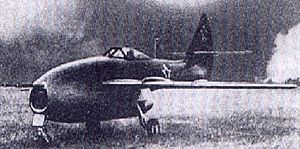Lavochkin Aircraft 160 Video - Wings of Russia - Fighters - The Jet Era
|
|
|
|
Lavochkin Aircraft 160
Lavochkin Aircraft 160 Strelka

Role: Jet Fighter
National origin: U.S.S.R.
Manufacturer: Lavochkin Design Bureau (OKB-301)
Designed by: Semyon Alekseyevich Lavochkin
First flight: 23rd July 1947
Number built: 1
Aircraft 160 strelka(Arrow) a.k.a. La-160 was a swept winged jet fighter research prototype designed and manufactured by the Lavochkin Design Bureau from 1946. USAF reporting name - Type 6
Design and development
Aircraft 160 was an all-metal pod and boom style aircraft with tri-cycle undercarriage and mid set wings with 35 sweep at 1/4 chord. The afterburning engine was underslung in the nose with the air intake at the extreme nose, and exhaust under the rear fuselage. The tri-cycle undercarriage was housed entirely within the fuselage, (almost all Lavochkin jet aircraft had a similar undercarriage arrangement) when retracted allowing the wing to be built thinner and lighter. A conventional tail layout with 35 swept tailplane was located at the end of the tail boom. The swept wings were of very low taper (almost constant chord)with 1/2 span flaps/ailerons and two wing fences each side.
Although designed as a fighter, Aircraft 160 was intended for research into high speed swept-wing flight, of which little was known in the mid 1940's. Following closely the layout of his previous jet fighter prototypes Lavochkin was able to produce an aircraft capable of providing useful data and experience of high speed flight near the speed of sound.
Successful flight trials were quickly followed by public display at the 1947 Aviation Day airshow at Tushino. Trials continued until Aircraft 160 broke up in flight, due to wing flutter, during tests to establish the maximum attainable speed. The experience gained with Aircraft 160 spurred on Soviet aircraft designers to design swept winged fighters, albeit cautiously.
The title 'Aircraft 160' was used previously by Lavochkin for a 'Heavy' twin engined fighter to be produced concurrently with Aircraft 150. This project was still-born, but led to the Alekseyev twin-engined I-21 series of fighters, after Alekseyev left Lavochkin's design bureau to head OKB-21 at Gor'kiy.
Specifications (Aircraft 160)
Data from Gordon,Yefim. Lavochkin's Last Jets. Midland Publishing. Hinkley. 2007. ISBN(10) 1 85780 253 5
General characteristics
Crew: One
Length: 10.06 m (33 ft 0 in)
Wingspan: 8.95 m (29 ft 4 in)
Height: 4.125 m (13 ft 6 in)
Wing area: 15.9 m² (170.96 ft²)
Empty weight: 2,738 kg (6,036 lb)
Gross weight: 4,060 kg (8,950 lb)
Powerplant: 1 x— YuF afterburning RD-10, 8.83 kN (1,984 lbf) thrust dry, 11.17 kN (2,510 lbf) with afterburner
Performance
Maximum speed: 970 km/h (602 mph)
Range: 1,000 km (621 miles)
Service ceiling: 12,000 m (40,030 ft)
Rate of climb: 19.84 m/s (3905 ft/min)
Armament
2 x 37mm cannon
Lavochkin Aircraft 174TK
Comparable aircraft
Yakovlev Yak-30
Yakovlev MiG I-310
Gunston, Bill. The Osprey Encyclopedia of Russian Aircraft 1875-1995. London:Osprey, 1995. ISBN 1 85532 405 9.
Gordon,Yefim. Early Soviet Jet Fighters. Midland Publishing. Hinkley. 2002. ISBN 1 85780 139 3
Gordon,Yefim. Lavochkin's Last Jets. Midland Publishing. Hinkley. 2007. ISBN(10) 1 85780 253 3
Living Warbirds: The best warbirds DVD series.
Source: WikiPedia